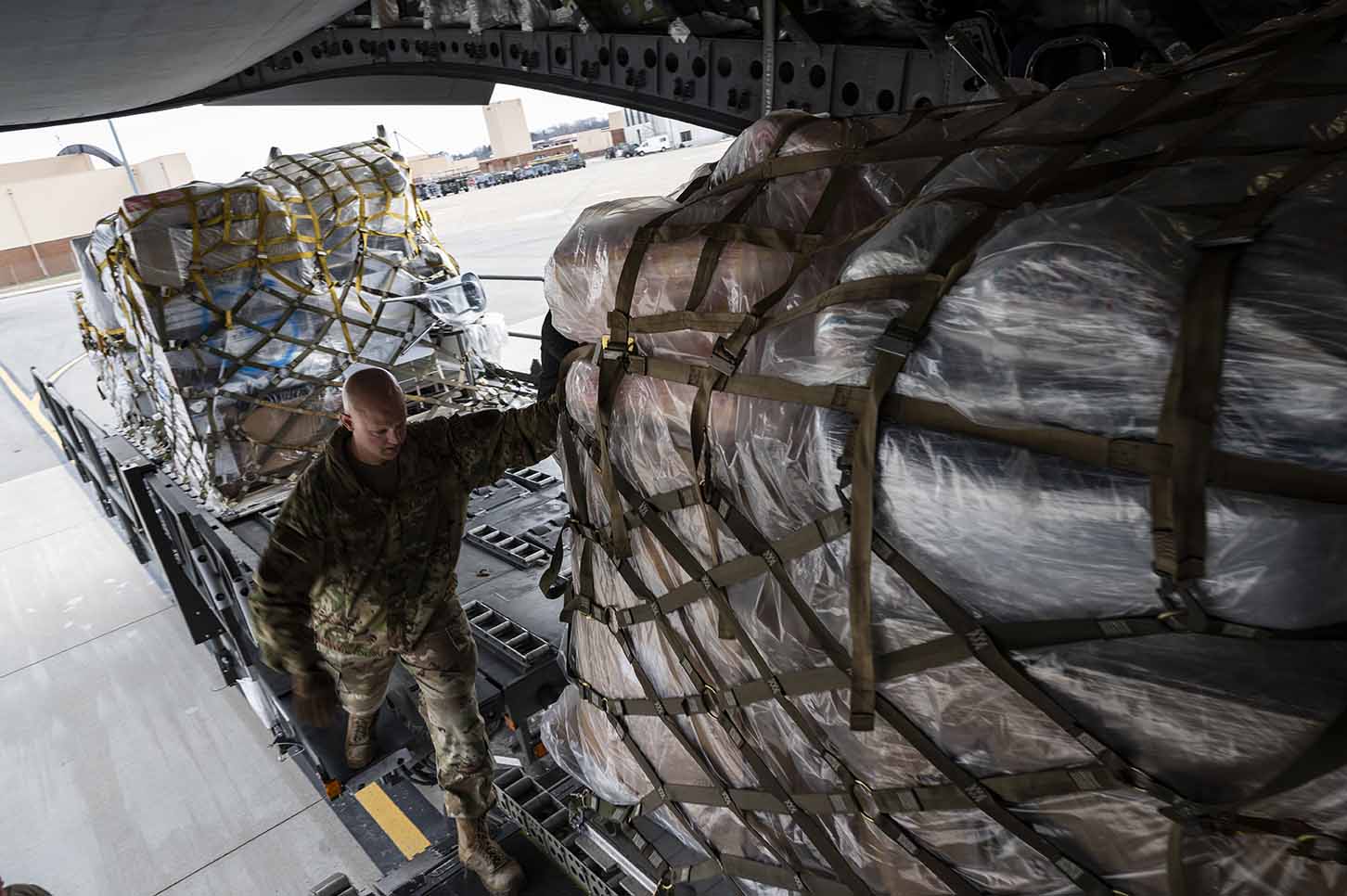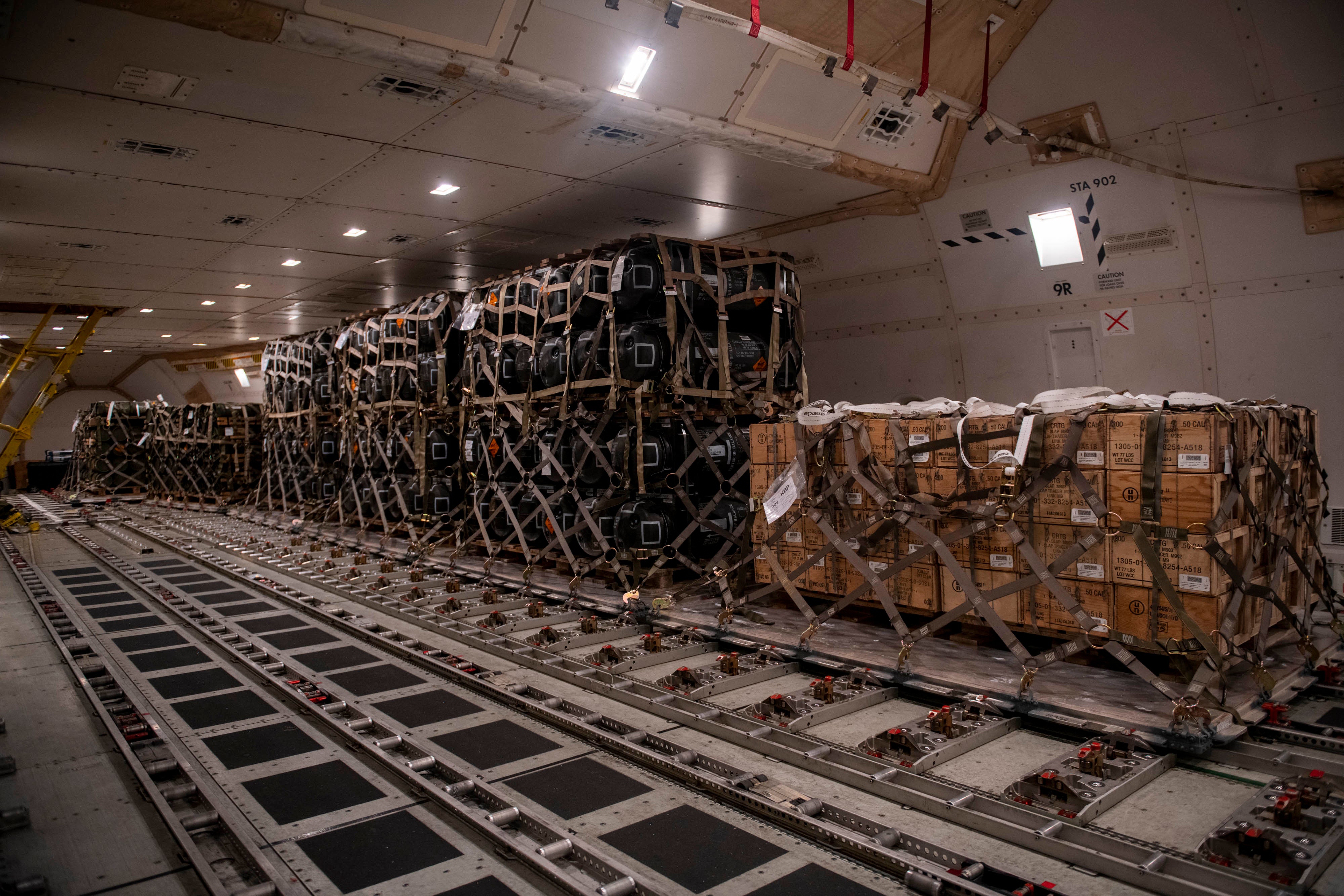Master Sgt. Justin Tamburro, 32nd Aerial Port Squadron fleet services flight chief, loads cargo for the Department of Defense's Denton Program onto a C-17 Globemaster III at the Pittsburgh International Airport Air Reserve Station, Pennsylvania, Feb. 16, 2022. The Denton Program is a Department of Defense transportation program that moves humanitarian cargo, donated by U.S. based non-governmental organizations to developing nations to ease human suffering. (U.S. Air Force photo by Joshua J. Seybert)
In a concerted effort to alleviate the humanitarian crisis in northern Gaza, the U.S. Central Command, in collaboration with the Royal Jordanian Air Force, has undertaken a significant airdrop operation, marking a critical step in international aid efforts for the region. This initiative underscores the growing concern for the civilian population caught in the midst of ongoing conflicts and the innovative approaches being adopted to ensure the delivery of essential supplies.
On a recent day, Pentagon Press Secretary Air Force Maj. Gen. Pat Ryder announced during a briefing that three U.S. C-130 aircraft had successfully dropped over 36,800 meals into northern Gaza. This operation represents the second such collaborative humanitarian mission between the U.S. and Jordan, following an initial airdrop of 38,000 meals along Gaza's coastline. These missions are pivotal in providing immediate relief to those in dire need and are part of a broader strategy to address the humanitarian situation in Gaza through various means of aid delivery.
The significance of these airdrops cannot be understated. They not only provide much-needed nourishment to the civilian population but also signal a commitment to overcoming logistical and political challenges that often hinder the flow of humanitarian aid. By utilizing air and potentially sea routes, the U.S. and its partners are exploring every avenue to ensure that assistance reaches those who need it most.
During the same period, high-level discussions have been taking place to further the cause of humanitarian assistance in Gaza. Secretary of Defense Lloyd J. Austin III met with Israeli war cabinet member Minister Benny Gantz to address the ongoing humanitarian crisis. Austin expressed strong concerns over the situation and urged for Israel's cooperation in facilitating greater humanitarian aid distribution into Gaza. A critical aspect of this collaboration could be the opening of ground routes, such as the Kerem Shalom checkpoint, to augment the aid delivery process.
The emphasis on expanding aid delivery through land corridors and maritime options points to a comprehensive strategy aimed at circumventing the challenges that have historically limited humanitarian efforts in Gaza. The discussions around establishing a maritime corridor for aid delivery are particularly noteworthy. This innovative approach would involve creating a secure and efficient route through the Mediterranean for the transport of humanitarian supplies, potentially involving commercial and contracted vessels. Such an initiative, while complex, demonstrates an adaptive and multi-faceted strategy to humanitarian assistance, acknowledging the need for creative solutions in the face of restrictive circumstances.
Moreover, the U.S. government's commitment to reviewing options for a maritime corridor underlines the international dimension of the Gaza humanitarian crisis. It signals an intent to collaborate closely with international partners and agencies to facilitate aid delivery, reflecting a broader recognition of the shared responsibility to support vulnerable populations.
It's important to note that while these airdrops and potential maritime efforts represent a crucial lifeline for the people of Gaza, they also highlight the broader challenges associated with delivering humanitarian aid in conflict zones. The necessity of such operations underscores the ongoing difficulties in ensuring safe and unhindered access to affected areas, necessitating continuous dialogue and cooperation among all stakeholders involved, including the Israeli government and international humanitarian organizations.
As the U.S. and its allies forge ahead with plans for follow-on airborne aid delivery missions and explore new avenues for assistance, the overarching goal remains clear: to alleviate the suffering of Gaza's civilian population through sustained and innovative humanitarian efforts. The complexity of the situation in Gaza requires not only immediate relief efforts but also long-term strategies to ensure the continuous flow of humanitarian aid.
This collaborative endeavor between the U.S. Central Command, the Royal Jordanian Air Force, and other partners is a testament to the international community's resolve to address the pressing humanitarian needs in Gaza. It reflects a broader commitment to overcoming logistical challenges and geopolitical constraints to support those in dire need. As these efforts continue, it will be essential to monitor their impact on the ground and adapt strategies as necessary to ensure the most effective delivery of humanitarian assistance to the people of Gaza.
The recent humanitarian airdrops and ongoing discussions about expanding aid delivery mechanisms into Gaza mark a critical juncture in international efforts to address the humanitarian crisis in the region. Through innovative approaches and international collaboration, there is a concerted effort to provide relief and hope to those caught in the midst of conflict, signaling a commitment to humanitarian principles and the welfare of civilian populations in conflict zones.




Leave a comment
This site is protected by hCaptcha and the hCaptcha Privacy Policy and Terms of Service apply.